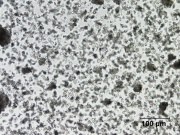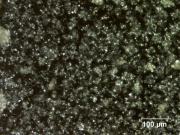Difference between revisions of "Rice starch"
Jump to navigation
Jump to search
| (2 intermediate revisions by 2 users not shown) | |||
| Line 1: | Line 1: | ||
| − | [[File:5_Rice_starch_200XS.jpg|thumb|Rice starch]] | + | [[File:5_Rice_starch_200XS.jpg|thumb|Rice starch at 200x transmitted light]] |
== Description == | == Description == | ||
| − | + | [[File:5_Rice_starch_200XS_pol.jpg|thumb|Rice starch at 200x polarized light]] | |
[[Polysaccharide]] granules that compose about 70% of the rice kernel. Rice starch is separated from the gluten and fibrous particles by sieving then wash flotation. Rice starch is composed of 17% [[amylose]]. Rice starch paste forms a weaker, but more stable, film than [[wheat starch|wheat starch paste]]. | [[Polysaccharide]] granules that compose about 70% of the rice kernel. Rice starch is separated from the gluten and fibrous particles by sieving then wash flotation. Rice starch is composed of 17% [[amylose]]. Rice starch paste forms a weaker, but more stable, film than [[wheat starch|wheat starch paste]]. | ||
| Line 8: | Line 8: | ||
rice glue; rice gum; rice powder | rice glue; rice gum; rice powder | ||
| − | + | == Risks == | |
| − | == | ||
| − | + | Susceptible to biodeterioration. Dried films become brittle with age. | |
| − | + | == Physical and Chemical Properties == | |
| − | |||
| − | |||
| − | |||
| − | == | + | * Fine, angular granules. |
| − | + | * Granule size = 3 - 8 micrometers. | |
| − | + | * Gelatinization temperature = 68 - 78 C | |
| + | * Reacts with a iodine/potassium iodide solution to give a positive purple color | ||
| − | == | + | == Resources and Citations == |
* G.S.Brady, ''Materials Handbook'', McGraw-Hill Book Co., New York, 1971 Comment: p. 766 | * G.S.Brady, ''Materials Handbook'', McGraw-Hill Book Co., New York, 1971 Comment: p. 766 | ||
| Line 31: | Line 28: | ||
* Book and Paper Group, ''Paper Conservation Catalog'', AIC, 1984, 1989 | * Book and Paper Group, ''Paper Conservation Catalog'', AIC, 1984, 1989 | ||
| − | * ''Encyclopedia Britannica'', http://www.britannica.com Comment: "cereal processing" | + | * ''Encyclopedia Britannica'', http://www.britannica.com Comment: "cereal processing" [Accessed April 8, 2002]. |
| − | * Art and Architecture Thesaurus Online, | + | * Art and Architecture Thesaurus Online, https://www.getty.edu/research/tools/vocabulary/aat/, J. Paul Getty Trust, Los Angeles, 2000 |
[[Category:Materials database]] | [[Category:Materials database]] | ||
Latest revision as of 16:14, 25 August 2022
Description
Polysaccharide granules that compose about 70% of the rice kernel. Rice starch is separated from the gluten and fibrous particles by sieving then wash flotation. Rice starch is composed of 17% Amylose. Rice starch paste forms a weaker, but more stable, film than wheat starch paste.
Synonyms and Related Terms
rice glue; rice gum; rice powder
Risks
Susceptible to biodeterioration. Dried films become brittle with age.
Physical and Chemical Properties
- Fine, angular granules.
- Granule size = 3 - 8 micrometers.
- Gelatinization temperature = 68 - 78 C
- Reacts with a iodine/potassium iodide solution to give a positive purple color
Resources and Citations
- G.S.Brady, Materials Handbook, McGraw-Hill Book Co., New York, 1971 Comment: p. 766
- Rosalie Rosso King, Textile Identification, Conservation, and Preservation, Noyes Publications, Park Ridge, NJ, 1985
- Matt Roberts, Don Etherington, Bookbinding and the Conservation of Books: a Dictionary of Descriptive Terminology, U.S. Government Printing Office, Washington DC, 1982
- Book and Paper Group, Paper Conservation Catalog, AIC, 1984, 1989
- Encyclopedia Britannica, http://www.britannica.com Comment: "cereal processing" [Accessed April 8, 2002].
- Art and Architecture Thesaurus Online, https://www.getty.edu/research/tools/vocabulary/aat/, J. Paul Getty Trust, Los Angeles, 2000

